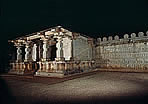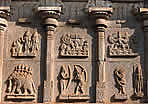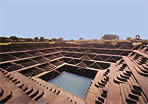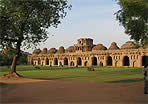| Royal Centre |
| The Royal Centre occupies the western end of the Urban Core. The roughly ovoid zone, narrower to the southwest and opening to northeast is contained within its own arc of fort walls, though these are no longer complete. Large gateways leading into the Royal Centre stand to the east, now forlorn in the middle of fields. The Royal Centre is where the Vijayanagara kings and their private households lived and conducted the daily business of ceremony and government. A good deal of the zone is subdivided into irregular interlocking compounds by high slender walls built of tightly fitted granite blocks that face a rubble core. The Hazara Rama Temple, which served as a royal chapel, is the hub of the enclosures of the Royal Centre. One of the principal roads of the city that runs to the northeast from the temple, through a gateway in the enclosure wall, is lined with lesser shrines. Other roads lead to the north, east and southeast. Gateways give access to adjoining enclosures. Among the many points of interest about the temple are the depictions of royal processions and courtly festivals carved in relief on the outside of its enclosing walls. The compound southeast of the Hazara Rama Temple is linked with the public and ceremonial life of the Vijayanagara kings. Here can be seen the basement of an extensive audience hall. There are 100 stone footings for columns, presumably made of timber, than have long ago disappeared. The nearby multi-storeyed Great Platform, popularly associated with the Mahanavami festival, stands nearby. Its lowest granite stages are covered with animated reliefs portraying the life of the Vijayanagara kings. A stepped tank immediately to the south, and other nearby bathing places, were probably used on particular festival occasions. A short distance to the southeast of this enclosure stands the queens’ bath, probably intended for the amusement of the Vijayanagara king and his courtiers. Built in a quasi-Islamic style characteristic of Vijayanagara courtly architecture, it has an ornate interior arcade with balconies running around a sunken square pool. Other courtly structures are seen in the compound northeast of the Hazara Rama Temple, known misleadingly as the zenana enclosure. It contains the basement of the largest palace structure in city. The nearby two-storeyed Lotus Mahal, was probably a royal pavilion. Like the queens’ bath, it too is built in the fanciful Vijayanagara courtly style. A vaulted hall nearby may have served as a treasury or gymnasium. Watchtowers also influenced by Islamic design overlook the enclosure. Immediately outside this enclosure are the Elephant Stables. These comprise a long line of eleven chambers roofed by alternating vaults and domes in a distinct Islamic style. These face west onto an open ground where troops and animals would have paraded. On the north side of the parade ground is a building with a high arcaded porch and an interior court, possibly used to view military displays in front and martial entertainments such as wrestling and boxing matches inside. Excavations in the compounds west of the Hazara Rama Temple have revealed the remains of numerous palaces, presumably for the royal household. One complex of fifteen palaces has even been labelled the Noblemen’s Quarter. An important early shrine located in this palace zone is known as the Underground Temple, because it was built in a small valley and was later partly buried by eroded soil. The shrine at its core is dedicated to Virupaksha, the same god worshiped at Hampi. For a report on and interpretation of the features of the Royal Centre see Fritz, Michell and Nagaraja Rao 1984, City of Victory, Vijayanagara, in Bibliography. |
|
|||||||



